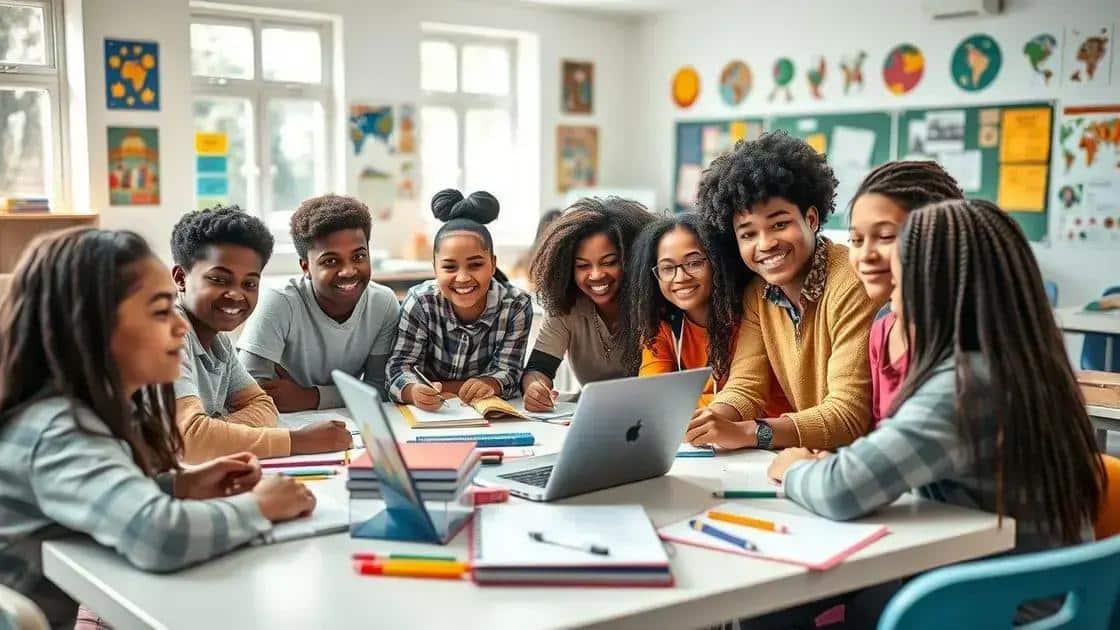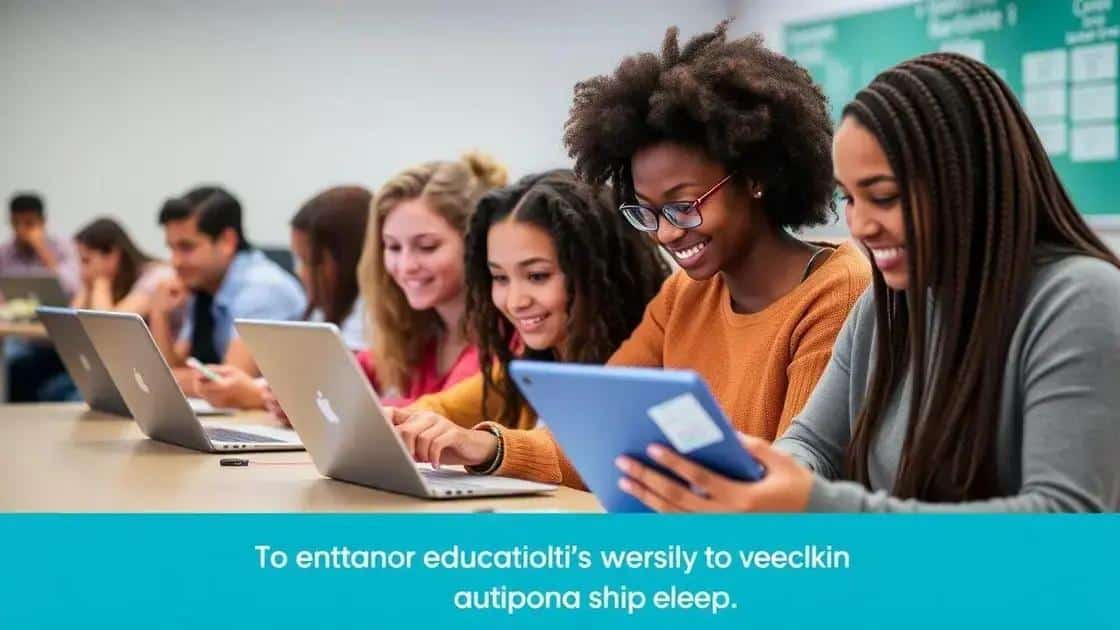Higher education accessibility: breaking down barriers

Higher education accessibility involves addressing barriers like tuition costs, resource availability, and discrimination while leveraging technology and community support to create inclusive learning environments for all students.
Higher education accessibility plays a crucial role in shaping the future of students. Have you ever considered how these barriers impact educational journeys? Let’s dive into the current challenges and explore paths to more inclusive education.
Understanding higher education accessibility
Understanding higher education accessibility is vital for ensuring that all students can pursue their academic goals. It involves recognizing the various factors that impact a student’s ability to access quality education.
Many people think of accessibility in physical terms, like wheelchair ramps or accessible classrooms. However, it goes far beyond that. Factors such as financial barriers, cultural differences, and technological limitations also play significant roles in accessibility.
Key Components of Accessibility
There are several critical components to consider when addressing higher education accessibility:
- Physical access to campus facilities
- Financial aid opportunities
- Support services for diverse learners
- Inclusive teaching practices
Each of these components contributes to an environment where every student can thrive. For instance, financial aid can greatly reduce the burden of tuition and fees, allowing more students to attend college.
Importance of Inclusivity
A focus on inclusivity ensures that students from all backgrounds feel welcome. Higher education accessibility also means creating a supportive atmosphere. For example, providing mentoring programs can help first-generation college students navigate the complexities of academic life.
Additionally, schools often implement technology to support learning, such as online resources and adaptive software. This empowers students with disabilities to participate fully in their education. By prioritizing inclusivity and accessibility, colleges can create a richer educational experience for all.
Current barriers to access in higher education

Current barriers to access in higher education can significantly impact students’ ability to succeed. Understanding these obstacles is crucial in creating more equitable educational environments. Many students face hurdles like financial constraints, lack of resources, and social stigma that can inhibit their academic journeys.
One major barrier is the cost of tuition and related expenses. Many families struggle to afford higher education, leading to student debt or discouragement from pursuing college altogether. Additionally, students from low-income backgrounds may not have access to preparatory resources, such as tutors or college counseling.
Common Barriers
Here are some of the main barriers affecting access:
- High tuition and fees
- Limited financial aid availability
- Insufficient support for first-generation college students
- Discrimination and social stigma
Another barrier is the inadequate support for first-generation college students. They often lack guidance in navigating college processes, which can lead to feelings of isolation. Social stigma related to race, gender, or disability can also discourage some students from pursuing higher education.
The Role of Technology
Technology can both help and hinder access. Online resources are useful for providing information and expanding learning opportunities. However, students without reliable internet access can face significant challenges. Moreover, the reliance on technology sometimes can overlook the needs of those who prefer traditional learning methods.
It’s essential to address these current barriers to ensure that every student has the chance to succeed in higher education. Institutions must actively work towards identifying and dismantling these obstacles.
Innovative solutions improving education accessibility
Innovative solutions improving education accessibility are essential for creating an inclusive learning environment. With changes in technology and educational practices, many institutions are finding effective ways to reach all students. These solutions help eliminate barriers that previously hindered access to higher education.
One of the most significant innovations is the use of online learning platforms. These platforms allow students to access course materials from anywhere, making education more flexible. This flexibility enables learners from various backgrounds to participate and succeed.
Key Innovations in Accessibility
Several innovative solutions can enhance accessibility:
- Adaptive learning technologies that tailor educational experiences
- Financial aid programs designed for low-income students
- Community partnerships to offer mentoring and support services
- Multilingual resources to support diverse student populations
Adaptive learning technologies use algorithms to assess students’ needs and customize their education. This approach can significantly improve learning outcomes, as each student receives tailored support. Financial aid programs specifically designed for low-income students help to alleviate the financial burden, allowing more individuals to pursue their educational goals.
Community Engagement and Support
Building partnerships with community organizations can provide students with additional resources. These partnerships often offer mentoring, tutoring, and other support services that are crucial for students facing challenges. Such collaboration fosters a sense of belonging and enhances the educational experience.
Moreover, creating multilingual resources ensures that non-native speakers have the same opportunities as their peers. Making all materials accessible in multiple languages fosters inclusivity and encourages diversity in higher education.
The role of technology in enhancing access to education

The role of technology in enhancing access to education is significant and growing daily. Technology provides diverse tools and resources, helping break down barriers that prevent students from achieving their educational goals. By leveraging digital platforms and innovative applications, educators can reach more students effectively.
Online learning platforms have transformed traditional education. These platforms offer courses that anyone can access from the comfort of their homes. Students no longer need to travel to attend classes, making education more convenient for those with time or mobility challenges.
Key Technological Advancements
Here are some key technologies improving education accessibility:
- Video conferencing tools for remote learning
- Learning management systems to organize courses
- Accessible educational apps designed for diverse learners
- Open educational resources available online
Video conferencing tools have played a crucial role in connecting teachers and students, allowing for real-time interaction. Learning management systems help organize curriculum, materials, and assessments, making it easier for students to engage with their studies. Additionally, educational apps cater to different learning styles, ensuring that every student can benefit from the resources provided.
Impact of Digital Resources
Open educational resources (OER) are another innovation that enhances accessibility. These resources include textbooks, videos, and courses available for free online. Providing these materials can reduce financial burdens and make quality education available to all.
Technology also enables personalized learning experiences. With data analytics, educators can assess a student’s learning progress more effectively, tailoring lessons to meet individual needs. This customization is vital for helping students from all backgrounds succeed in their studies.
FAQ – Frequently Asked Questions about Higher Education Accessibility
What are the main barriers to accessing higher education?
The main barriers include high tuition costs, limited financial aid, lack of resources for first-generation students, and discrimination.
How does technology enhance access to education?
Technology provides online learning platforms, adaptive learning tools, and resources that make education accessible to more students.
What role do community partnerships play in education accessibility?
Community partnerships offer additional resources, mentorship, and support services that help students overcome challenges.
What innovative solutions are being implemented to improve accessibility?
Innovative solutions include adaptive technologies, open educational resources, and flexible online courses that accommodate diverse learning needs.






